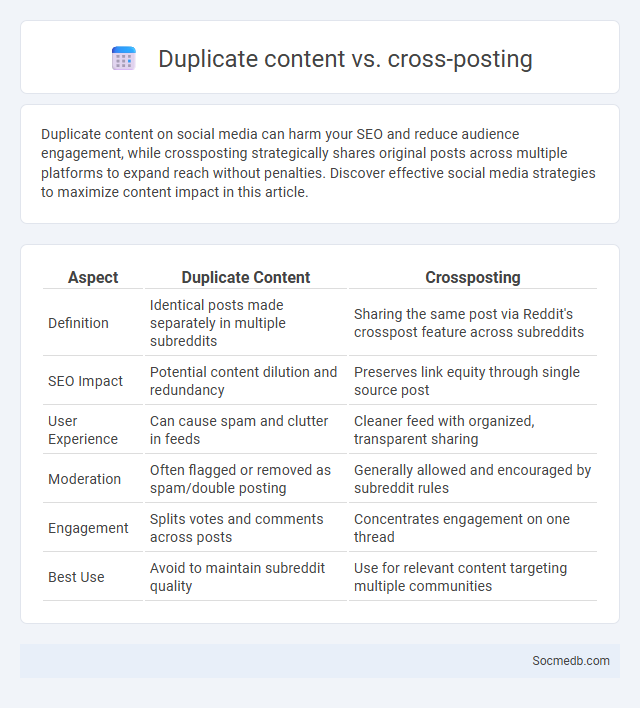
Photo illustration: duplicate content vs crossposting
Duplicate content on social media can harm your SEO and reduce audience engagement, while crossposting strategically shares original posts across multiple platforms to expand reach without penalties. Discover effective social media strategies to maximize content impact in this article.
Table of Comparison
| Aspect | Duplicate Content | Crossposting |
|---|---|---|
| Definition | Identical posts made separately in multiple subreddits | Sharing the same post via Reddit's crosspost feature across subreddits |
| SEO Impact | Potential content dilution and redundancy | Preserves link equity through single source post |
| User Experience | Can cause spam and clutter in feeds | Cleaner feed with organized, transparent sharing |
| Moderation | Often flagged or removed as spam/double posting | Generally allowed and encouraged by subreddit rules |
| Engagement | Splits votes and comments across posts | Concentrates engagement on one thread |
| Best Use | Avoid to maintain subreddit quality | Use for relevant content targeting multiple communities |
Understanding Duplicate Content: Definitions and Types
Duplicate content refers to substantial blocks of text that appear identically across different web pages or social media posts, potentially harming your platform's SEO performance and user engagement. Types include exact duplicates, near-duplicates with minor variations, and cross-domain duplicates found when content from one website is replicated on another without significant changes. Understanding these variations helps you maintain unique, original posts that improve your social media visibility and avoid algorithm penalties.
What Is Crossposting? A Modern Content Strategy
Crossposting is a modern content strategy that involves sharing the same content across multiple social media platforms to maximize reach and engagement. By leveraging crossposting, your content can appear in diverse audiences on Facebook, Instagram, Twitter, LinkedIn, and other channels without the need to create unique posts for each. This technique enhances brand visibility, saves time, and maintains consistent messaging across your digital presence.
Rule Violations: Navigating Platform Policies
Social media platforms enforce strict rule violations policies to maintain a safe online environment, targeting behaviors like hate speech, harassment, and misinformation. Understanding these platform guidelines helps you avoid penalties such as content removal, account suspension, or permanent bans. Adhering to these policies ensures your social media presence remains compliant and credible.
Key Differences: Duplicate Content vs. Crossposting
Duplicate content on social media refers to posting identical or nearly identical content across multiple platforms or accounts, which can harm engagement and lead to platform penalties. Crossposting involves sharing content adapted or tailored for different platforms, enhancing reach while maintaining originality and audience relevance. Understanding these distinctions helps optimize social media strategies for better visibility and user interaction.
SEO Impacts: How Duplicate Content Affects Rankings
Duplicate content on social media platforms can significantly harm your SEO rankings by causing search engines to struggle in determining the original source of information, which leads to lower visibility in search results. Search engines penalize duplicated posts by filtering them out or ranking them lower, reducing your content's reach and authority. Ensuring your social media posts are unique and tailored to each platform helps protect your SEO efforts and improves your overall search engine ranking.
Crossposting Best Practices for Maximum Reach
Crossposting on social media involves sharing identical or similar content across multiple platforms to maximize reach and engagement. Best practices include tailoring the message to fit the unique audience and format of each platform, optimizing hashtags and keywords to enhance discoverability, and scheduling posts at peak times based on platform-specific analytics. Avoiding duplicate content penalties and monitoring performance through insights tools ensures sustained growth and effective audience interaction.
Recognizing and Avoiding Rule Violations
Understanding social media platform policies is essential for recognizing and avoiding rule violations that can lead to account suspension or content removal. You should carefully review community guidelines, especially those related to hate speech, harassment, spam, and copyright infringement, to protect your online presence. Staying informed about platform updates helps ensure your content complies with evolving standards and maintains your account's integrity.
Legal and Ethical Considerations in Content Sharing
When sharing content on social media, respecting copyright laws and obtaining proper permissions is essential to avoid legal repercussions. Your posts must adhere to platform guidelines and privacy regulations to protect personal data and prevent misuse. Ethical content sharing promotes trust and credibility by ensuring accuracy, attribution, and sensitivity to potentially offensive material.
Tools and Techniques to Detect Duplicate Content
Social media platforms employ sophisticated tools like content hashing, fingerprinting algorithms, and artificial intelligence to detect duplicate content efficiently. Techniques such as natural language processing (NLP) analyze textual similarities while image recognition software identifies duplicate visuals across posts. These methods help maintain content originality, reduce spam, and enhance user engagement by ensuring unique and authentic posts.
Final Recommendations: Safe and Effective Content Distribution
Ensure content distribution on social media aligns with platform policies and prioritizes user privacy and data security. Utilize algorithms that promote authentic engagement while mitigating the spread of misinformation by verifying sources and flagging false content. Leverage scheduled posting tools and audience analytics to optimize reach and maintain consistent, safe interaction across diverse demographic groups.
 socmedb.com
socmedb.com